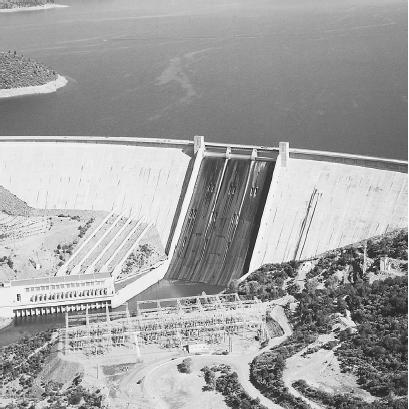Energy - How it works
Work: What It Is and Is Not
Work may be defined in general terms as the exertion of force over a given distance. In order for work to be accomplished, there must be a displacement in space—or, in colloquial terms, something has to be moved from point A to point B. As noted earlier, this definition creates results that go against the common-sense definition of "work."
A person straining, and failing, to pull a rock from the ground has performed no work (in terms of physics) because nothing has been moved. On the other hand, a child on a playground performs considerable work: as she runs from the slide to the swing, for instance, she has moved her own weight (a variety of force) across a distance. She is even working when her movement is back-and-forth, as on the swing. This type of movement results in no net displacement, but as long as displacement has occurred at all, work has occurred.
Similarly, when a man completes a full push-up, his body is in the same position—parallel to the floor, arms extended to support him—as he was before he began it; yet he has accomplished work. If, on the other hand, he at the end of his energy, his chest is on the floor, straining but failing, to complete just one more push-up, then he is not working. The fact that he feels as though he has worked may matter in a personal sense, but it does not in terms of physics.
CALCULATING WORK.
Work can be defined more specifically as the product of force and distance, where those two vectors are exerted in the same direction. Suppose one were to drag a block of a certain weight across a given distance of floor. The amount of force one exerts parallel to the floor itself, multiplied by the distance, is equal to the amount of work exerted. On the other hand, if one pulls up on the block in a

Similarly, if one exerts force on the block at an angle to the floor, only a portion of that force counts toward the net product of work—a portion that must be quantified in terms of trigonometry. The line of force parallel to the floor may be thought of as the base of a triangle, with a line perpendicular to the floor as its second side. Hence there is a 90°-angle, making it a right triangle with a hypotenuse. The hypotenuse is the line of force, which again is at an angle to the floor.
The component of force that counts toward the total work on the block is equal to the total force multiplied by the cosine of the angle. A cosine is the ratio between the leg adjacent to an acute (less than 90°) angle and the hypotenuse. The leg adjacent to the acute angle is, of course, the base of the triangle, which is parallel to the floor itself. Sizes of triangles may vary, but the ratio expressed by a cosine (abbreviated cos) does not. Hence, if one is pulling on the block by a rope that makes a 30°-angle to the floor, then force must be multiplied by cos 30°, which is equal to 0.866.
Note that the cosine is less than 1; hence when multiplied by the total force exerted, it will yield a figure 13.4% smaller than the total force. In fact, the larger the angle, the smaller the cosine; thus for 90°, the value of cos = 0. On the other hand, for an angle of 0°, cos = 1. Thus, if total force is exerted parallel to the floor—that is, at a 0°-angle to it—then the component of force that counts toward total work is equal to the total force. From the standpoint of physics, this would be a highly work-intensive operation.
GRAVITY AND OTHER PECULIARITIES OF WORK.
The above discussion relates entirely to work along a horizontal plane. On the vertical plane, by contrast, work is much simpler to calculate due to the presence of a constant downward force, which is, of course, gravity. The force of gravity accelerates objects at a rate of 32 ft (9.8 m)/sec 2 . The mass ( m ) of an object multiplied by the rate of gravitational acceleration ( g ) yields its weight, and the formula for work done against gravity is equal to weight multiplied by height ( h ) above some lower reference point: mgh.

Distance and force are both vectors—that is, quantities possessing both magnitude and direction. Yet work, though it is the product of these two vectors, is a scalar, meaning that only the magnitude of work (and not the direction over which it is exerted) is important. Hence mgh can refer either to the upward work one exerts against gravity (that is, by lifting an object to a certain height), or to the downward work that gravity performs on the object when it is dropped. The direction of h does not matter, and its value is purely relative, referring to the vertical distance between one point and another.
The fact that gravity can "do work"—and the irrelevance of direction—further illustrates the truth that work, in the sense in which it is applied by physicists, is quite different from "work" as it understood in the day-to-day world. There is a highly personal quality to the everyday meaning of the term, which is completely lacking from its physics definition.
If someone carried a heavy box up five flights of stairs, that person would quite naturally feel justified in saying "I've worked." Certainly he or she would feel that the work expended was far greater than that of someone who had simply allowed the the elevator to carry the box up those five floors. Yet in terms of work done against gravity, the work done on the box by the elevator is exactly the same as that performed by the person carrying it upstairs. The identity of the "worker"—not to mention the sweat expended or not expended—is irrelevant from the standpoint of physics.
Measurement of Work and Power
In the metric system, a newton (N) is the amount of force required to accelerate 1 kg of mass by 1 meter per second squared (m/s 2 ). Work is measured by the joule (J), equal to 1 newton-meter (N · m). The British unit of force is the pound, and work is measured in foot-pounds, or the work done by a force of 1 lb over a distance of one foot.
Power, the rate at which work is accomplished over time, is the same as work divided by time. It can also be calculated in terms of force multiplied by speed, much like the force-multiplied-by-distance formula for work. However, as with work, the force and speed must be in the same direction. Hence, the formula for power in these terms is F · cos θ · v, where F =force, v =speed, and cos θ is equal to the cosine of the angle θ (the Greek letter theta) between F and the direction of v.
The metric-system measure of power is the watt, named after James Watt (1736-1819), the Scottish inventor who developed the first fully viable steam engine and thus helped inaugurate the Industrial Revolution. A watt is equal to 1 joule per second, but this is such a small unit that it is more typical to speak in terms of kilowatts, or units of 1,000 watts.
Ironically, Watt himself—like most people in the British Isles and America—lived in a world that used the British system, in which the unit of power is the foot-pound per second. The latter, too, is very small, so for measuring the power of his steam engine, Watt suggested a unit based on something quite familiar to the people of his time: the power of a horse. One horsepower (hp) is equal to 550 foot-pounds per second.
SORTING OUT METRIC AND BRITISH UNITS.
The British system, of course, is horridly cumbersome compared to the metric system, and thus it long ago fell out of favor with the international scientific community. The British system is the product of loosely developed conventions that emerged over time: for instance, a foot was based on the length of the reigning king's foot, and in time, this became standardized. By contrast, the metric system was

During the revolutionary era, French intellectuals believed that every aspect of existence could and should be treated in highly rational, scientific terms. Out of these ideas arose much folly—especially after the supposedly "rational" leaders of the revolution began chopping off people's heads—but one of the more positive outcomes was the metric system. This system, based entirely on the number 10 and its exponents, made it easy to relate one figure to another: for instance, there are 100 centimeters in a meter and 1,000 meters in a kilometer. This is vastly more convenient than converting 12 inches to a foot, and 5,280 feet to a mile.
For this reason, scientists—even those from the Anglo-American world—use the metric system for measuring not only horizontal space, but volume, temperature, pressure, work, power, and so on. Within the scientific community, in fact, the metric system is known as SI, an abbreviation of the French Système International d'Unités —that is, "International System of Units."
Americans have shown little interest in adopting the SI system, yet where power is concerned, there is one exception. For measuring the power of a mechanical device, such as an automobile or even a garbage disposal, Americans use the British horsepower. However, for measuring electrical power, the SI kilowatt is used. When an electric utility performs a meter reading on a family's power usage, it measures that usage in terms of electrical "work" performed for the family, and thus bills them by the kilowatt-hour.
Three Types of Energy
KINETIC AND POTENTIAL ENERGY FORMULAE.
Earlier, energy was defined as the ability of an object to accomplish work—a definition that by this point has acquired a great deal more meaning. There are three types of energy: kinetic energy, or the energy that something possesses by virtue of its motion; potential energy, the energy it possesses by virtue of its position; and rest energy, the energy it possesses by virtue of its mass.
The formula for kinetic energy is KE = ½ mv 2 . In other words, for an object of mass m, kinetic energy is equal to half the mass multiplied by the square of its speed v. The actual derivation of this formula is a rather detailed process, involving reference to the second of the three laws of motion formulated by Sir Isaac Newton (1642-1727.) The second law states that F = ma , in other words, that force is equal to mass multiplied by acceleration. In order to understand kinetic energy, it is necessary, then, to understand the formula for uniform acceleration. The latter is v f 2 = v 0 2 + 2 as, where v f 2 is the final speed of the object, v 0 2 its initial speed, a acceleration and s distance. By substituting values within these equations, one arrives at the formula of ½ mv 2 for kinetic energy.
The above is simply another form of the general formula for work—since energy is, after all, the ability to perform work. In order to produce an amount of kinetic energy equal to ½ mv 2 within an object, one must perform an amount of work on it equal to Fs. Hence, kinetic energy also equals Fs, and thus the preceding paragraph simply provides a means for translating that into more specific terms.
The potential energy (PE) formula is much simpler, but it also relates to a work formula given earlier: that of work done against gravity. Potential energy, in this instance, is simply a function of gravity and the distance h above some reference point. Hence, its formula is the same as that for work done against gravity, mgh or wh, where w stands for weight. (Note that this refers to potential energy in a gravitational field; potential energy may also exist in an electromagnetic field, in which case the formula would be different from the one presented here.)
REST ENERGY AND ITS INTRIGUING FORMULA.
Finally, there is rest energy, which, though it may not sound very exciting, is in fact the most intriguing—and the most complex—of the three. Ironically, the formula for rest energy is far, far more complex in derivation than that for potential or even kinetic energy, yet it is much more well-known within the popular culture.
Indeed, E = mc 2 is perhaps the most famous physics formula in the world—even more so than the much simpler F = ma. The formula for rest energy, as many people know, comes from the man whose Theory of Relativity invalidated certain specifics of the Newtonian framework: Albert Einstein (1879-1955). As for what the formula actually means, that will be discussed later.
Comment about this article, ask questions, or add new information about this topic: